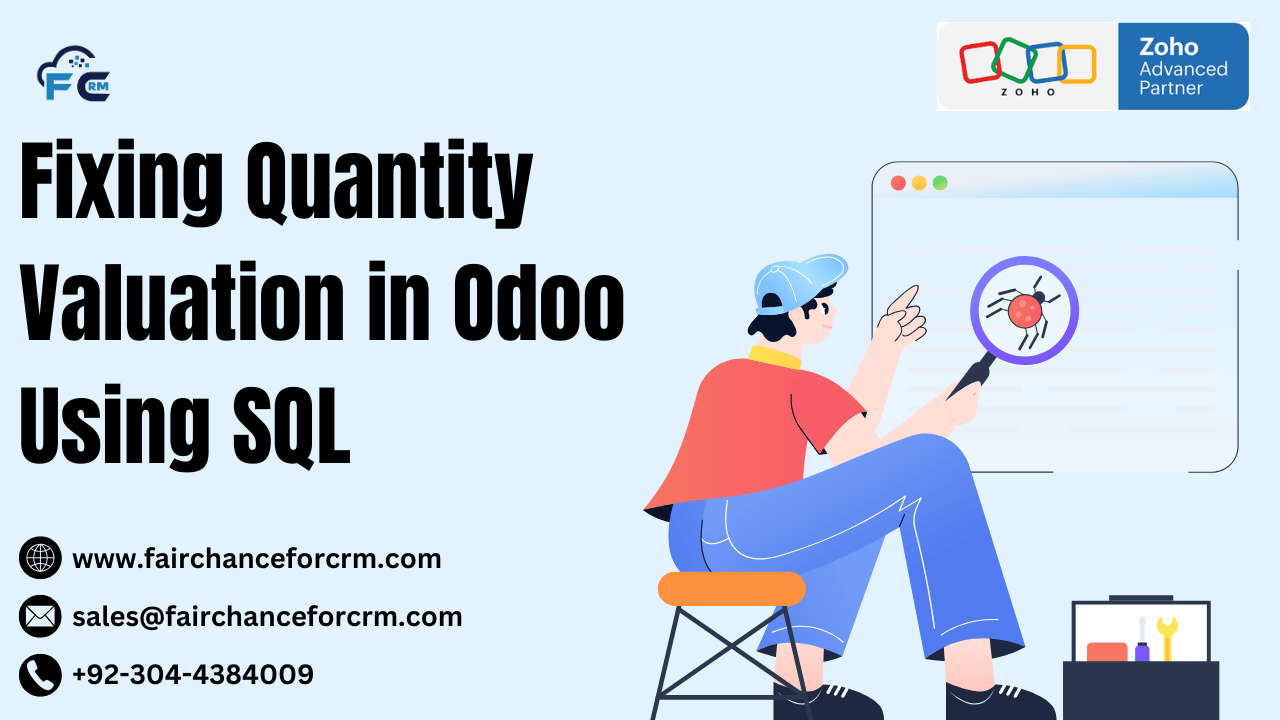Odoo is a powerful open-source Enterprise Resource Planning (ERP) system that offers a range of modules to manage different business functions, from sales and inventory management to accounting and manufacturing. One of the most critical aspects of inventory management is quantity valuation, which ensures that stock levels and product valuations are accurately tracked in the system.
In this article, we will discuss Fixing Quantity Valuation in Odoo Using SQL queries. We will explore common issues, how to identify and fix them using SQL, and best practices for maintaining accurate quantity valuations in Odoo.
Also Read:
- Next.js and Odoo
- How to Copy Odoo Docker with Database
- Odoo Pactera – A Powerful Partnership
- Kubernetes and Odoo
- Why Doesn’t Odoo Process Provide the Option to Block
Understanding Fixing Quantity Valuation in Odoo Using SQL
In Odoo, quantity valuation refers to the process of calculating the value of inventory items based on their quantities. This involves tracking both the stock level (the number of items) and the valuation (the monetary value of the stock). This process ensures that inventory values are accurate for accounting, reporting, and other financial purposes.
Odoo provides three main methods for inventory valuation:
- Real-time (perpetual) valuation: Inventory valuation is updated in real-time as products are moved in and out of stock.
- Manual valuation: Inventory valuation is updated manually based on periodic stock takes.
- Automated valuation: Inventory values are automatically calculated using predefined formulas such as FIFO (First In, First Out) or AVCO (Average Cost).
However, issues can arise when the quantity valuation is incorrect, such as when stock levels are not synchronized with their corresponding monetary value.
Common Issues with Quantity Valuation in Odoo
- Stock Discrepancies: Sometimes, the physical quantity of items in the warehouse doesn’t match the quantity recorded in Odoo. This can happen due to errors in receiving products, incorrect stock moves, or incomplete stock adjustments.
- Incorrect Product Valuation: The valuation of products might not be updated correctly when stock levels are adjusted manually or when items are moved between locations. This can lead to discrepancies in the accounting records and inaccurate reporting.
- Outdated Inventory Valuation: In some cases, the inventory valuation may not reflect the latest stock prices, especially if FIFO or AVCO methods are being used and not properly maintained.
- Lost or Untracked Stock Movements: If stock movements (e.g., goods received or sold) are not properly recorded, it can lead to missing or incorrect data in the valuation.
Fixing Quantity Valuation in Odoo Using SQL
SQL queries can help identify and fix quantity valuation issues directly within the Odoo database. Below, we provide examples of common SQL queries that can be used to fix problems related to quantity valuation in Odoo.
1. Checking Current Stock Quantities
Before making any corrections, it’s important to understand the current state of the stock quantities in the database. Use the following SQL query to check the quantity on hand for each product:
This query retrieves the total quantity of each product in a specific location (replace <location_id> with the correct location ID). The stock_quant table stores information about quantities in stock for each product in Odoo.
2. Checking Product Valuation
To check the current product valuation, you can query the product_template table to get the valuation method and pricing details:
This query retrieves the product names, their associated cost price, and the valuation method from the product_template table. If the valuation method is not set correctly, it may be necessary to update this field.
3. Updating Product Valuation Using FIFO or AVCO
If the product valuation method (FIFO or AVCO) is incorrect, you can update the product valuation method through SQL. For instance, to set the valuation method to FIFO for a specific product, you can run the following query:
This query updates the standard cost of a product, which may be necessary if the product’s valuation needs to be corrected manually.
4. Fixing Stock Discrepancies
If you have discrepancies in stock quantities, such as missing or extra items in your warehouse, you can use SQL to adjust the stock levels manually. For example, to update the stock quantity for a specific product in a certain location:
This query allows you to manually adjust the quantity of a specific product in a given location to match the physical count.
5. Correcting Lost Stock Movements
If stock movements have not been recorded properly, you may need to insert missing stock moves into the database. The following query inserts a new stock move:
This query creates a new stock move from a source location to a destination location with the specified product and quantity.
Best Practices for Fixing Quantity Valuation in Odoo Using SQL
- Regular Stock Audits: Perform regular physical stock audits to ensure that your physical quantities match the recorded quantities in Odoo.
- Automated Valuation Method: Use an automated inventory valuation method such as FIFO or AVCO to ensure that inventory values are consistently updated.
- Correct Stock Moves: Always ensure that stock movements are recorded accurately and in real-time. Manual adjustments should be minimized to prevent discrepancies.
- Train Staff: Properly train warehouse and inventory management staff to ensure they understand how to use Odoo effectively and accurately input stock-related data.
- Backup Data Regularly: Before making any changes to your inventory or valuation records, always back up your database to prevent data loss.
Conclusion
Fixing Quantity Valuation in Odoo Using SQL requires careful attention to the underlying data and an understanding of how Odoo tracks inventory and product valuations. Businesses may keep accurate inventory records and guarantee appropriate financial reporting by using SQL queries to monitor and modify stock levels, update product valuations, and resolve inconsistencies.
Even though Odoo has built-in tools to manage inventory valuation, SQL queries can be an effective tool for identifying and resolving potential problems. You can make sure that your quantity valuations stay accurate and dependable and support the smooth and effective operation of your organization by adhering to best practices and routinely auditing your stock.
For more information about Fixing Quantity Valuation in Odoo Using SQL, visit this link.
If you want to Free Trail Zoho, click on this link.




